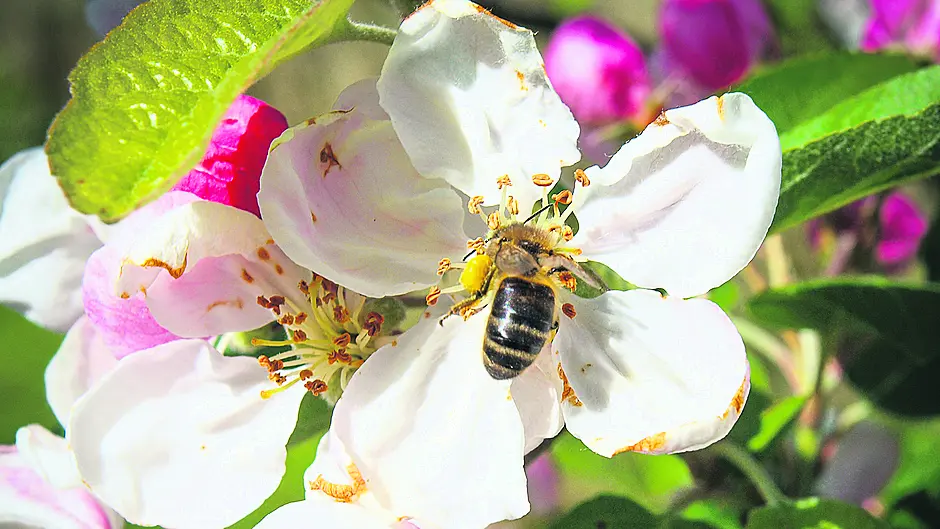By Joyce Russell
IT’S been pretty dry for a while before writing this and dry soils may not get enough moisture from small amounts of rain. A shower will freshen foliage and give a drink to shallow rooting plants, but you need to scratch a little deeper to find out how damp your soil really is. Raised or sloping beds dry out faster than those ‘on the flat’ and you may need to use a watering can or hose-pipe to provide what thirsty plants need. Use water carefully if there is any shortage and use it where it is needed most. Beans, peas, onions and garlic all produce the best crops if they have plenty of moisture when flowering or swelling bulbs and tiny seedlings will keel over if they are left to dry out.
Pots and containers dry out quickly and the compost may need wetting every day. A breeze aids drying and containers against the wall of a house don’t get the full benefit of any rain.
Apple blossom time
My apple trees flower a little later than those in seaside gardens. I’m often happy about this because it means there is less chance of frost destroying the blossom as the season moves on. Frost hasn’t been an issue for a while now, let’s hope this continues and the apple trees set lots of those beautiful flowers.
If birds eat the blossom, try hanging something that moves and glitters among the branches. You won’t protect every flower but nor do you need to – an average tree will set more fruits than it can ripen to maturity. Some of this excess fruit is shed as small fruitlets in June and July, which is nature’s way of ensuring the tree isn’t put under too much strain.
Plant Brussels sprouts
Brussels sprouts grow fast and young plants need to get roots in the ground. Take care at planting time if you want to get good crops. Don’t add too much manure to the bed, but compost is fine. Dig this into the whole bed or just fill planting holes with half a bucket for each plant.
Water planting holes well and push a strong stick into the ground next to each one. Don’t damage roots when planting and firm the soil down around the plant. Sprinkle a little lime if needed and a few organic approved slug pellets will protect small plants. Do put squares of plastic around each plant on the ground. This stops cabbage root fly from laying eggs close to the stem. Don’t leave any gaps and use two overlapping plastic squares if needed.
I cover the whole bed with crop cover for a couple of weeks. This lets plants settle in without any disturbance from wind or birds.
Border flowers
There are lots of lovely bedding plants in shops, garden centres, and on market stalls now. They really don’t cost much and they can be a fast way to brighten up a garden.
Annuals will flower quickly and provide an instant display. Try a few perennials if you want plants to last more than one season – they take a while to establish into large clumps, but at that point you can divide them and increase the numbers in your borders.
Under cover
A lot of the polytunnel will be planted now. Tomatoes, cucumbers, peppers, courgettes, peas, beans, salad, basil and aubergines should all be growing well.
Keep a close eye out for any problems and act as soon as you spot them. It’s better to get rid of one diseased plant than to let the problem spread to other healthy ones. Provide supports where needed so growing plants don’t put strain on stems.
You may need to water every day in bright weather. If you water more deeply, you may only need to water every other day.
Remember to spray the first tomato flowers with a light mist of water if you want to aid fruit set.
Keep sowing more lettuce and salad leaves if you want a continuous supply. Salad bolts faster undercover in hot weather than it does outdoors.
What to plant out right now
Climbing French and runner beans: these can be planted in a greenhouse or polytunnel. Only plant them outside when you are sure all risk of frost is passed, or if you can protect them with fleece on a cold night.
Sweetcorn: These plants put down long roots and they do best if they can grow uninterrupted. Plants can go into a polytunnel or greenhouse bed now – wait another week or so before planting outdoors.
Pumpkins and squash: These are some of the fastest growing plants but only put them out in the garden when it is warm enough. Cover with a cloche if you must get them out and be prepared to open this daily if plants start to flower.









